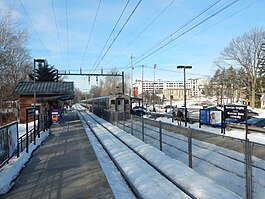The Montclair-Boonton Line is a commuter rail line of New Jersey Transit Rail Operations in the United States. It is part of the Hoboken Division. The line is a consolidation of three individual lines: the former Delaware, Lackawanna & Western Railroad's Montclair Branch, which ran from Hoboken Terminal to Bay Street, Montclair. The Erie Railroad's Greenwood Lake Division, a segment from Montclair to Mountain View-Wayne, originally ran from the Jersey City Terminal to Greenwood Lake, NY, and the former Lackawanna Boonton Line ran from Hoboken to Hackettstown, New Jersey.
The Montclair-Boonton line was formed when the Montclair Connection opened on September 30, 2002. The line serves 28 active rail stations in New Jersey along with New York Pennsylvania Station. It crosses through six counties, serving six stations in the township of Montclair, two in the town of Bloomfield, and one in the city of Newark. Trains along the Montclair-Boonton Line heading eastward usually originate at Hackettstown, Mount Olive, Lake Hopatcong, Dover, or Montclair State University, bound for either Hoboken Terminal or New York Penn Station. On system maps the line is colored maroon and its symbol is a bird, after the state bird, the eastern goldfinch.
For 2010, of 31 inbound and 34 outbound daily weekday trains, 21 inbound and 22 outbound Midtown Direct trains (about 66%) use the Kearny Connection to Secaucus Junction and New York Penn Station; the rest go to Hoboken Terminal. Trains to Hoboken run only at rush hour. Passengers can transfer at Secaucus Junction, Newark Broad Street Station, Montclair State University, or Dover to reach other destinations if necessary. Truncated weekend service on the Montclair-Boonton Line began on November 8, 2009, with service every two hours between Bay Street station in Montclair and Hoboken terminal, with the train making all local stops.[2] This was an extension of existing Hoboken-to-Newark service, previously listed on the Morris & Essex timetables.
Plans for connecting the two lines (the New York & Greenwood Lake Railroad, later the Boonton Line and the Montclair Branch, dated back to 1929, when a rail connection through Montclair was proposed. Despite years of debate over the connection, nothing came to fruition until 1991. Lackawanna Terminal in Montclair closed in 1981, replaced by the new Bay Street station on the alignment that eventually would extend to the connection. In 1991, studies were conducted by New Jersey Transit regarding the creation of the Montclair Connection, and in 2002, after construction was completed, the Boonton Line from east of Walnut Street station to Arlington served as a freight-only line.
All passenger trains took the new alignment via the Montclair Branch between a rebuilt Bay Street station and Walnut Street. Service began on September 30, 2002 and three stations on the former Boonton Line were closed: Benson Street in Glen Ridge, Rowe Street in Bloomfield, and Arlington station in Kearny. As of 2022, the surplus rail bed is being repurposed as a rail trail.[3][4]
Besides the Montclair Connection, service was extended in 1994 from Netcong station to Hackettstown via tracks owned by Conrail (now Norfolk Southern). Stations at Roseville Avenue in Newark, Ampere in East Orange, and Great Notch in Little Falls were closed in 1984, 1991, and 2010 respectively. Two service expansions have been proposed using the under-construction branch to Andover via the Lackawanna Cut-Off Restoration Project, an extension on old New York and Greenwood Lake tracks to Pompton Junction, and the New York, Susquehanna and Western. The latter of these two proposals has not gone through as the Greenwood Lake Tracks from Wayne to Riverdale Borough have been removed for a Rail Trail. There is also a proposal to extend service along the Washington Secondary as a rapid transit improvement to the New Jersey Route 57 corridor via Washington Borough to Phillipsburg.
- ^ "NJ TRANSIT QUARTERLY RIDERSHIP TRENDS ANALYSIS November 2012" (PDF). Archived from the original (PDF) on April 19, 2013. Retrieved December 16, 2016.
- ^ "Montclair – Boonton Line Timetables – January 17, 2010 edition" (PDF). New York, New York: New Jersey Transit Rail Operations. 2010. Retrieved February 20, 2010.
- ^ "Essex Hudson Greenway | A Potential Linear Park for Northern New Jersey". Essex Hudson Greenway. Retrieved December 13, 2022.
- ^ Finn, Jennifer (January 21, 2022). "Why NJ's Essex-Hudson Greenway Will be a Game-Changer for Commuters, City Residents". New Jersey Monthly. Retrieved December 13, 2022.

